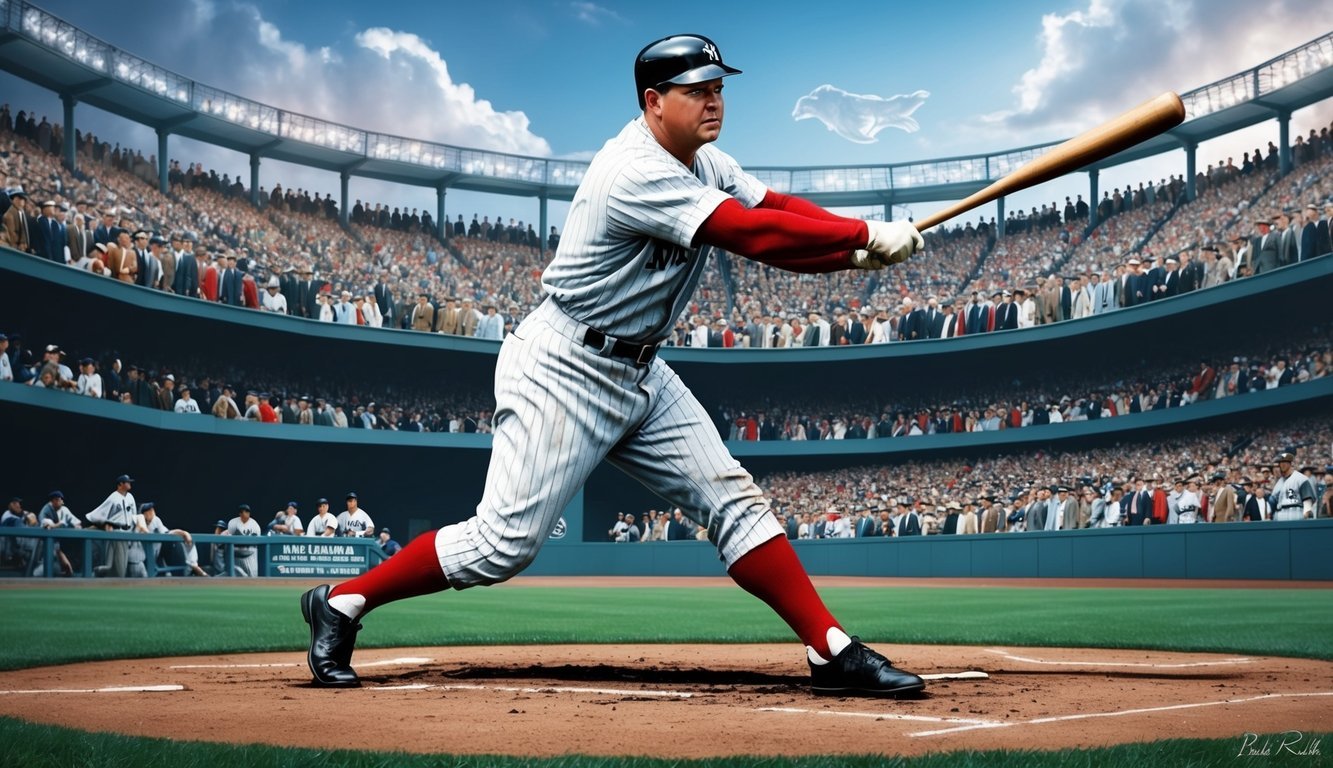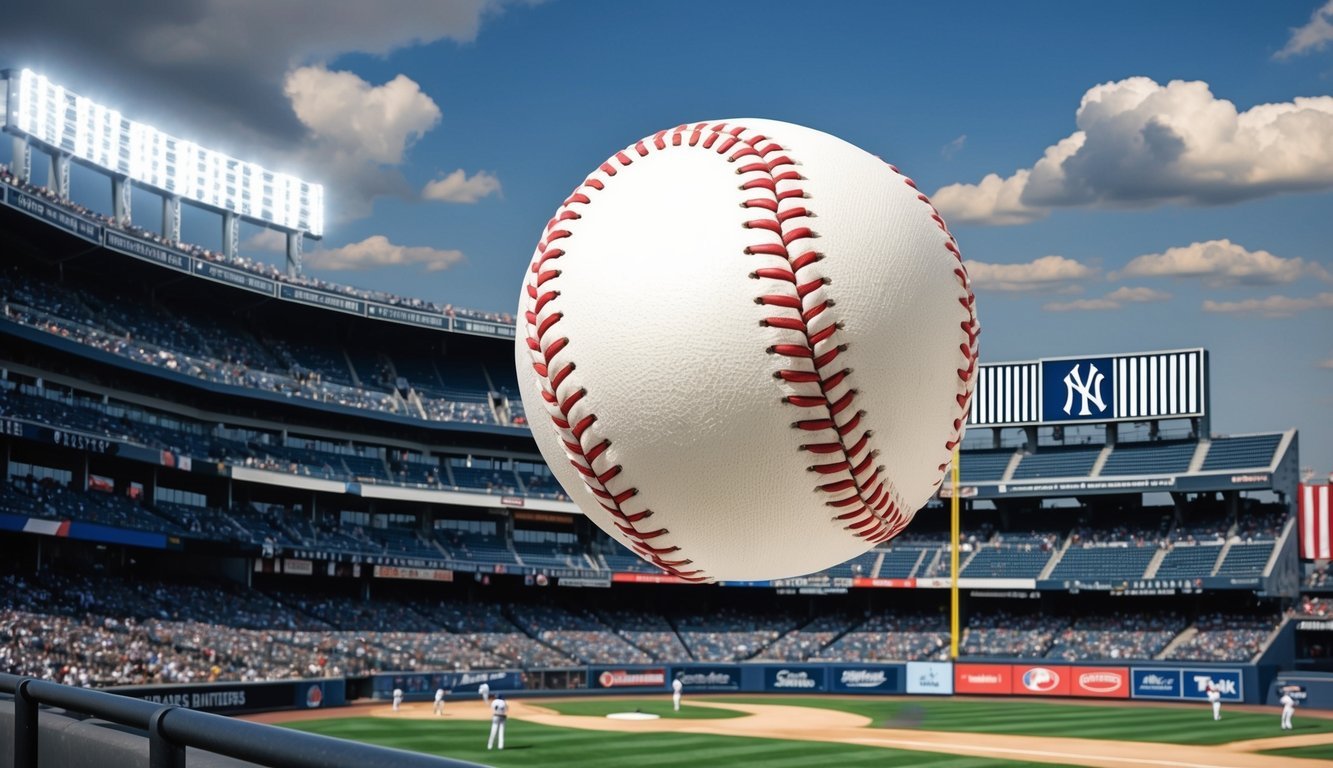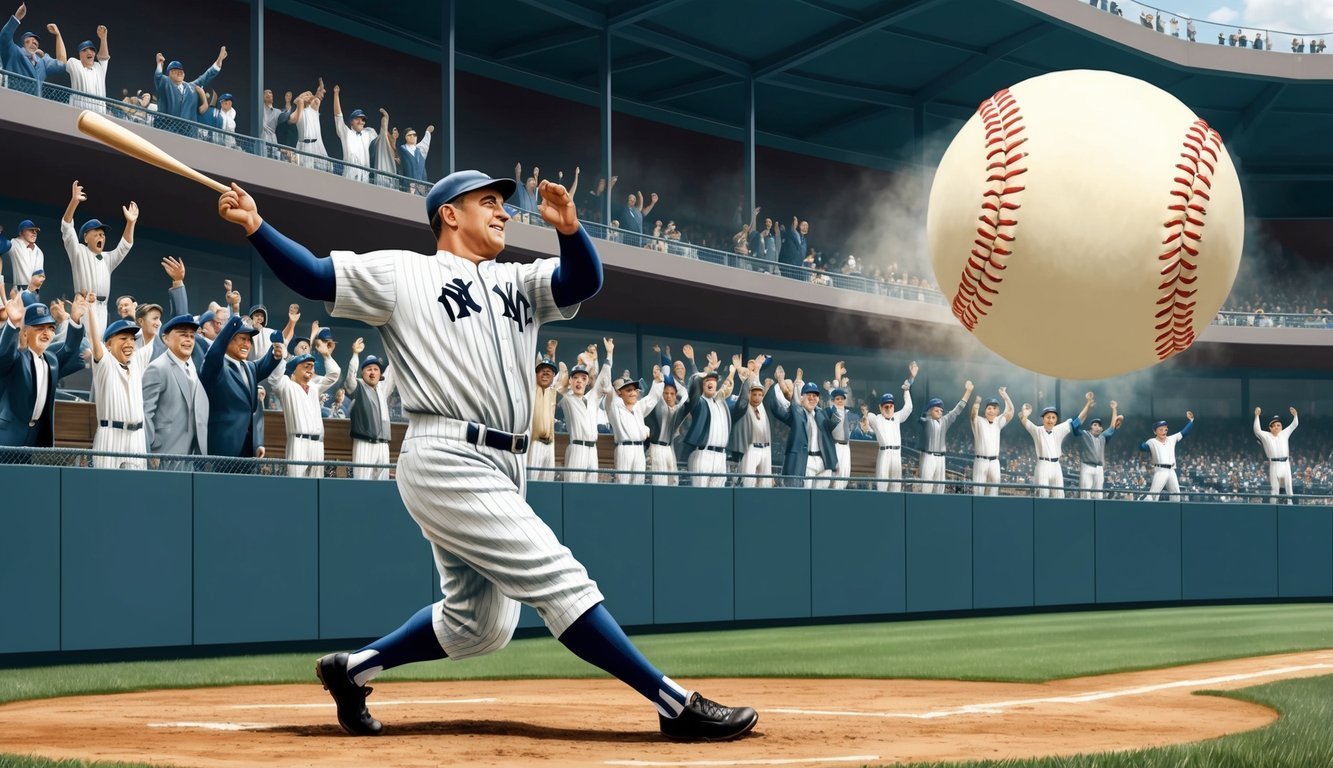Babe Ruth transformed baseball in the 1920s, ushering in a new era dominated by the home run.
The slugger’s incredible power and charisma captivated fans across America, turning the sport into a national obsession. Ruth’s record-breaking 60 home runs in 1927 set a new standard for power hitting and changed the way the game was played.
Ruth’s journey to becoming the “Sultan of Swat” began with the Boston Red Sox, where he initially excelled as a pitcher.
His move to the New York Yankees in 1920 marked a turning point, allowing him to focus on hitting full-time.
Ruth’s towering home runs became legendary, with tales of 500-foot blasts capturing the public’s imagination.
The Babe’s influence extended beyond the baseball diamond.
His larger-than-life personality and prodigious appetite made him a cultural icon.
As Ruth’s home run totals soared, so did attendance at ballparks across the country.
Fans flocked to see the Yankee slugger in action, forever altering the economics of professional baseball.
Babe Ruth’s Early Years and Red Sox Era

Babe Ruth’s journey from a troubled youth to baseball superstardom began in Baltimore and flourished with the Boston Red Sox.
His transformation from a dominant pitcher to a legendary slugger revolutionized the game.
A Start in Baltimore and the Boston Legacy
George Herman “Babe” Ruth was born on February 6, 1895, in Baltimore, Maryland.
As a rowdy youngster, he was sent to St. Mary’s Industrial School for Boys.
There, Brother Matthias introduced him to baseball.
In 1914, Jack Dunn signed Ruth to the Baltimore Orioles.
His skills quickly caught the eye of the Boston Red Sox, who purchased his contract.
Ruth made his major league debut on July 11, 1914, at age 19.
With the Red Sox, Ruth emerged as one of the American League’s best left-handed pitchers.
He won 89 games over six seasons, including 24 in 1917.
Ruth also helped the Red Sox win three World Series titles in 1915, 1916, and 1918.
The Transition from Pitcher to Slugger
Ruth’s powerful hitting soon overshadowed his pitching prowess.
In 1918, he began playing outfield on days he wasn’t pitching to keep his bat in the lineup.
His home run totals steadily increased:
- 1918: 11 home runs
- 1919: 29 home runs (new single-season record)
This shift marked the beginning of Ruth’s transformation into baseball’s premier slugger.
His offensive output was unprecedented, drawing fans to ballparks in droves.
In 1919, Red Sox owner Harry Frazee sold Ruth to the New York Yankees.
This move, driven by financial reasons, would alter the course of baseball history and mark the end of Ruth’s Red Sox era.
The Birth of a Legend: Ruth and the Yankees

Babe Ruth’s move to the New York Yankees in 1920 transformed baseball forever.
His prodigious power and larger-than-life persona ushered in a new era for America’s pastime.
Creating The House That Ruth Built
Ruth’s incredible popularity led to skyrocketing attendance for Yankees games.
In 1923, the team opened their grand new ballpark in the Bronx.
Yankee Stadium quickly became known as “The House That Ruth Built.”
The spacious dimensions suited Ruth’s power-hitting style perfectly.
He christened the stadium with a home run in the very first game.
Ruth’s mammoth blasts thrilled fans and helped establish Yankee Stadium as baseball’s most famous venue.
The Bambino’s presence turned the Yankees into an instant powerhouse.
His 54 home runs in 1920 shattered his own previous record of 29.
Ruth followed that up with 59 homers in 1921, cementing his status as baseball’s biggest star.
Championship Success and the Roaring Twenties
Ruth led the Yankees to their first World Series title in 1923.
It marked the beginning of a dynasty that would dominate baseball for decades.
The team won three more championships with Ruth in 1927, 1928, and 1932.
The Roaring Twenties provided the perfect backdrop for Ruth’s exploits.
His outsized personality and love of the spotlight matched the exuberance of the era.
Ruth became more than just a baseball player – he was a cultural icon.
His fame transcended sports.
Ruth endorsed products, appeared in movies, and lived a famously lavish lifestyle.
He epitomized the excitement and excess of the 1920s while rewriting baseball’s record books.
Home Runs: Transforming the Game
Babe Ruth’s prodigious power hitting revolutionized baseball, ushering in a new era of excitement and strategy.
His home run prowess captivated fans and reshaped how teams approached the game.
Record-Breaking Home Run Achievements
Ruth’s home run totals were staggering for his time.
In 1919, he smashed 29 homers, an unheard-of feat in the Deadball Era.
This was just the beginning.
In 1920, his first year with the Yankees, Ruth blasted an astonishing 54 home runs – more than any other team except the Phillies.
His power hitting continued to astound.
Ruth’s career total of 714 home runs stood as the all-time record for decades.
He became the first player to reach milestones like 30, 40, 50, and 60 home runs in a season.
Ruth’s slugging percentage, a measure of his power hitting ability, was equally impressive.
He led the league in this statistic 13 times, showcasing his unmatched ability to hit for distance and power.
Influence on Team Strategy and Baseball Popularity
Ruth’s home run hitting changed how teams played the game.
Managers began to value power hitters more, shifting away from the small-ball tactics of the Deadball Era.
The “live-ball era” dawned, with rule changes favoring offense and more exciting play.
Baseball’s popularity soared as fans flocked to see Ruth and other sluggers.
The sport became America’s true national pastime during this “Golden Age of Sport” in the 1920s.
Attendance records were shattered as people came to witness the spectacle of the home run.
Ruth’s influence extended beyond the diamond.
His larger-than-life personality and prodigious feats made him one of America’s first sports celebrities.
He helped transform baseball into a major entertainment industry, paving the way for the modern era of the sport.
Legends and Legacies
Babe Ruth’s impact on baseball extended far beyond his playing days, shaping the sport’s history and popular culture for generations to come.
Rivals, Records, and the Hall of Fame
Babe Ruth’s legendary status was cemented through his fierce rivalries and jaw-dropping records.
Known as the “Sultan of Swat,” Ruth set an astounding 714 career home runs record that stood for decades.
His closest rival during his playing days was Lou Gehrig, forming the feared “Murderers’ Row” lineup.
Ruth’s records seemed unbreakable until Hank Aaron surpassed his home run total in 1974.
Despite this, Ruth’s name remained synonymous with baseball greatness.
In 1936, Ruth was part of the inaugural class inducted into the Baseball Hall of Fame.
His plaque in Cooperstown stands as a testament to his unparalleled contributions to America’s pastime.
Babe Ruth’s Impact Beyond Baseball
Ruth’s larger-than-life personality transcended the baseball diamond.
He became America’s first true sports celebrity, his fame reaching far beyond the ballpark.
Ruth’s name adorned countless products, from candy bars to baseball bats.
His likeness appeared in advertisements, movies, and radio shows.
The Babe’s charitable work, especially with children, endeared him to fans.
He visited hospitals, orphanages, and schools, using his fame to bring joy to others.
Even today, “Babe Ruth” remains a household name, symbolizing excellence in sports and American culture.
His legacy continues to inspire new generations of baseball fans and players alike.
Babe Ruth’s Final Years and Enduring Fame

Babe Ruth’s later life was marked by health struggles and a bittersweet farewell to baseball.
His legendary status grew even after retirement, cementing his place as an American icon.
Health Battles and Farewell
Babe Ruth’s final years in baseball were challenging.
On May 25, 1935, he hit his last three home runs in a single game at Forbes Field.
This remarkable performance proved to be his final hurrah.
Ruth’s health began to decline, and he retired from baseball shortly after.
In his post-baseball life, Ruth faced serious health issues.
He was diagnosed with throat cancer in 1946.
Despite his illness, Ruth remained a beloved figure.
His last public appearance at Yankee Stadium in 1948 drew thousands of fans.
Ruth passed away on August 16, 1948, at the age of 53.
The New York Times ran a front-page story, highlighting his impact on American culture.
The Immortal Bambino
Babe Ruth’s legacy continued to grow after his death.
He became a symbol of baseball’s golden age and American culture.
The Baseball Hall of Fame inducted Ruth in 1936.
His larger-than-life persona resonated with fans across generations.
Ruth’s name became synonymous with excellence in sports. “The House That Ruth Built” – Yankee Stadium – stood as a testament to his influence.
Ruth’s impact extended beyond baseball.
He represented the American Dream – rising from humble beginnings to achieve greatness.
His story inspired books, movies, and countless baseball products.
Today, Ruth remains a cultural touchstone.
His records may have been broken, but his status as a baseball icon endures.
